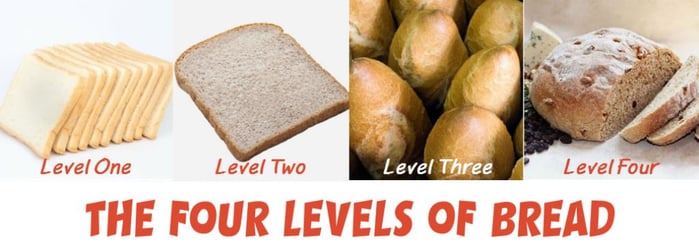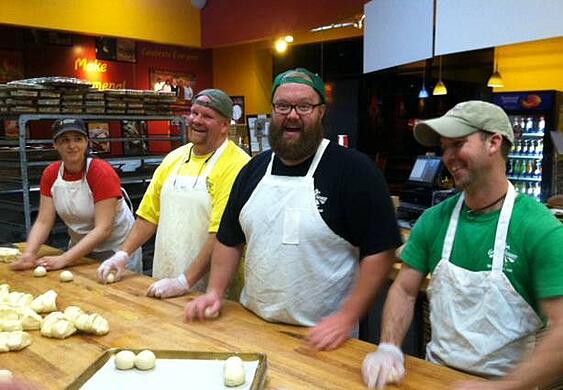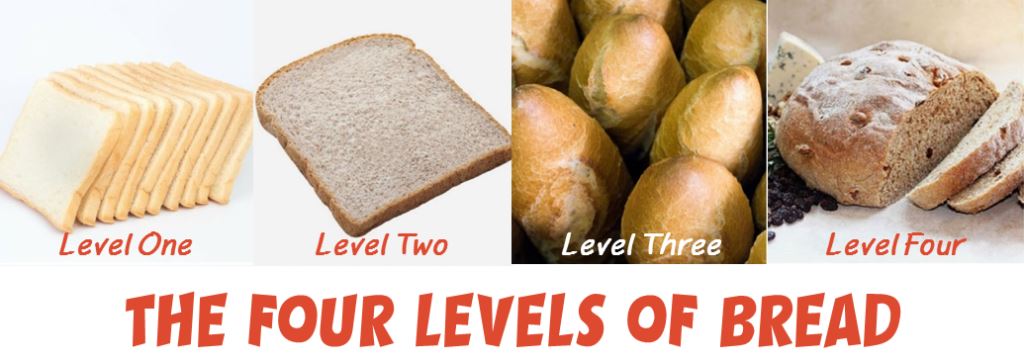The short answer is: because it’s worth it.
Bread is bread. Right? You can get it at any grocery store or gas station and be fine. Right? Actually, no.
There are really four levels of bread.

LEVEL ONE
Wonder Bread (and similar types) which are mass produced in factories and are full of chemicals and processes that eliminate most — if not all — of the nutritional value. Generally this is white flour or wheat flour bread. Those are not very good for you.LEVEL TWO
Then there is mass produced whole grain bread. This is better for you . . . but it is still factory bread. It is made with whole grain flour but it is highly processed. Everything we are starting to understand about nutrition says that the best diets are the least processed ones.LEVEL THREE
Then there is par baked bread. Most grocery stores and places like Panera do this. They want you to think the bread is fresh made but it isn’t. It comes to them frozen but already made and all they do is finish bake it. This class of bread may be whole wheat or not and it can taste okay. Trust me on this, any bread that is warm right out of the oven tastes great. Then you get it home and try to eat it over the course of a few days, not so much. We never judge warm bread for quality for just that reason. Taste test at room temperature and the distinctions become obvious.LEVEL FOUR
Then there is true artisan bread. This is the good stuff. The flours are special. The processes are special. Everything that goes into it is premium quality, fresh and simple. This class of bread often includes locally-sourced ingredients and unique flavor combinations that you can’t get anywhere else. The product is made with love. It includes any scratch baked product and can be anything from organic to hard crusted to whole wheat. Level four breads are what we do best so I will focus on that.
The whole wheat bread that you eat from Great Harvest starts as wheat on a family-owned farm in the Golden Triangle of Montana. The Golden Triangle grows the best wheat in the world and ours is exclusively from there. Before we buy the wheat we test it to make sure it passes our exacting baking standards. After we buy it we test it again, this time for chemicals and GMOs to make sure it is clean. We do that with all of our wheat, before we ship any of it out to bakeries. Only after passing that test does our wheat get final approval to go out to our bakeries and be served to you.
"Wheat berry to flour to bread in 36 hours or less is our thing."
Once the wheat arrives at a bakery it is fresh milled on site to ensure the freshest taste and highest quality. Wheat berry to flour to bread in 36 hours or less is our thing. All of our breads are handmade from scratch each day.

And the process is fun. When we say our products are made with love we mean it. The next time you visit a Great Harvest bakery, spend some time watching our kneaders and get a sense for the bakery’s vibe. If you don’t come away from that with a smile on your face, my advice would be to seek help. Possibly in the form of a cookie.
Who Doesn’t Love DIY? . . . At Least Until it Comes to the “D” Part . . .
It sounds simple enough in theory:
1. Get to know some farmers.
2. Buy their wheat when it is good (ideally, when its best).
3. Test it to make sure it is clean.
4. Mill the flour yourself.
5. Buy nothing but the freshest ingredients to go with it.
6. Knead and bake it by hand.
But that process is the furthest thing from simple I can think of. It would be outright impossible for the average person to clear step three in a single day. Most people don’t have the time or inclination to do this.
Relationships with Farmers
Establishing that history with farmers takes time— and they are business people, too. Friendship is great but so is money. We have to work with them on both fronts and that takes time and effort.
Testing
Testing should be easy, shouldn’t it? But it isn’t. No test to determine if wheat is “chemical free” even existed when we started our process. And that was just last year. We had to work with a lab to invent it. Simple? No. GMO testing? Well, that part is simple . . . but it is expensive.
Fresh Milling
Fresh milled? Again, that should be simple but it is a labor-intensive process and maintaining the actual mill is difficult. We have one person whose sole job is to maintain our mills.
Baking from Scratch
Baking by hand is simple but it is expensive and time-consuming.
To review, these steps are neither simple nor affordable. They are not possible to accomplish in a short period of time or with limited resources. It’s not a series of steps that would get much love in a business school class. It is not the most efficient path. Yet it’s the one we choose to take. Why? That brings us back to my original question.
Why don’t we take the easy way out?
If you are familiar with Great Harvest’s philosophy you know that we believe in sustainable growth and we care about remaining true to our real food values. Making level one, two, or three bread goes against everything we stand for, both in terms of process and end product quality.
The real reason we don't take shortcuts is because our way makes the best bread. We do it the old-fashioned way because we want to bake the best bread we can. And only the best. “Good enough” isn’t for us. After all, our name isn’t “Good Enough Harvest Bread Co.”
Some bake other ways because it is easier, faster and less costly. They don’t mind making level three bread. We do it our way because we set our bread bar higher, and this is the way to reach it.
Learn more about the Great Harvest Way of Doing Things:
You may also enjoy these posts on the merits of taking the slow road to quality:
- Bread Additives: Who Needs Them? We'll Stick to Our Slow Food Methods
- Why Great Harvest is Bread. The Way it Ought to Be.
- Why Local Retail Business Owners Need to Understand the Slow Movement





